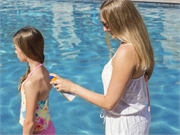Plasma concentrations exceeded 0.5 ng/mL for all six active ingredients with sunscreen application
WEDNESDAY, Jan. 22, 2020 (HealthDay News) — Sunscreen application is associated with geometric mean maximum plasma concentrations of all six active ingredients that exceed 0.5 ng/mL, according to a study published online Jan. 21 in the Journal of the American Medical Association.
Murali K. Matta, Ph.D., from the U.S. Food and Drug Administration in Silver Spring, Maryland, and colleagues examined the systemic absorption and pharmacokinetics of the six active ingredients in four sunscreen products in a randomized clinical trial conducted among 48 healthy participants; 44 participants completed the trial. Participants were randomly assigned to one of four sunscreen products formulated as lotion, aerosol spray, nonaerosol spray, and pump spray (12 each). Sunscreen products were applied to 75 percent of the body surface area on day 1 and four times on days 2 through 4 at two-hour intervals; blood samples were collected over 21 days.
The researchers found that for all six active ingredients, the geometric mean maximum plasma concentrations were greater than 0.5 ng/mL; for all active ingredients, this threshold was surpassed on day 1 after a single application. Rash was the most common adverse event and developed in 14 participants.
“In the absence of clear data demonstrating harm, the use of chemical sunscreen may still be considered appropriate; the use of mineral-based sunscreen is a well-established safe alternative,” write the authors of an accompanying editorial. “Elevating the science of the benefits and harms of sunscreen should be a priority.”
Copyright © 2020 HealthDay. All rights reserved.








